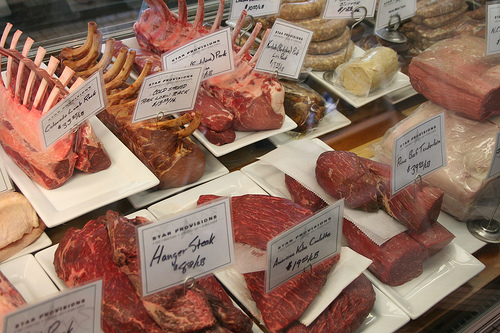Lab Meat Would Sidestep 'Grossly Inefficient' Livestock Industry

Though human life has changed much over a few hundred thousand years, the drive to kill and eat other animals lingers on from our earliest days.
But with technology transforming so many other aspects of daily life, will feedlots and slaughterhouses someday go the way of stone tools and cave dwellings? They may if scientists succeed in their experiments in culturing meat — muscle tissue grown in a laboratory dish. Supporters of the experiments see cultured meat as a way to end environmental degradation, not to mention addressing ethical qualms about eating animals.
“The livestock system we have is just so grossly inefficient, it really is like an artifact of an older, pre-industrial age,” said Jason Matheny, the founder of the nonprofit organization New Harvest, which funds evaluative papers on meat substitutes and small lab studies on in vitro meat.
In growing the stuff of steaks, sausages and short ribs, scientists are adapting techniques used to grow tissue for medical applications.
“We can grow strips of muscle tissue that look under the microscope exactly like muscle tissue from a living animal,” said Mark Post, a biotechnology engineer at Eindhoven University of Technology in the Netherlands, whose team is in the vanguard of cultured meat experimentation.
Post and his colleagues work with pork, taking pig myosatellite cells — a type of muscle stem cell — and growing them in a serum made from the blood of cow fetuses. Post then encourages the muscle to bulk up, bodybuilder-style, by putting it under mechanical tension and shocking it with electricity. This regimen can boost a sample’s volume several hundred percent.
At least by the numbers, lab meat like Post’s looks pretty good compared with meat meat. According to Matheny, livestock is responsible for 20 percent of global greenhouse emissions — more than cars. Furthermore, the consequences from unhealthy meat cost taxpayers $10 billion a year, he said. Scientists could engineer healthier meat, with more beneficial fatty acids and less overall fat — for example, a steak that contains the omega-3s of a trout.
Get the world’s most fascinating discoveries delivered straight to your inbox.
The obstacles in the way of commercializing cultured meat appear to be threefold: technical, financial, technical and culinary. Post said he and colleagues have been able to create only small, thin masses that are relatively poor in protein. Meanwhile, funding remains hard to come by. Post’s work in the Netherlands is between grants, and there are no U.S. projects with government funding. Matheny estimates that no more than a few hundred million dollars would do the trick.
And then there is the matter of how cultured meat tastes. Unofficial taste testers have not rated the experimental product high in either flavor or texture.
According to food research scientist Mirko Betti, who published a paper last year evaluating the potential for a cultured meat production system, scientists would need five years to overcome the technical hurdles of lab meat once the funding became available for their work.
In Matheny’s view, it’s impossible to predict when cultured meat might come to market, but he does think it is inevitable.
“We have an existence proof from nature that you can construct skeletal muscle and it can be a source of food," he said, "and I think there are sufficient social benefits, especially in health, that this will happen.”
This story was provided by InnovationNewsDaily, a sister site to LiveScience.


